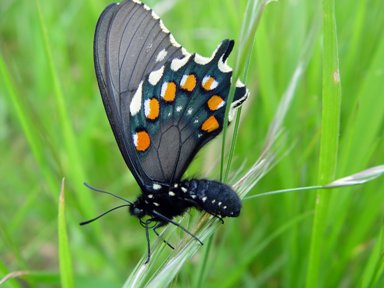Habitat
"Just living is not enough," said the butterfly. "One must have sunshine, Freedom and a little flower" - Hans Christian Anderson
Where can you find this beautiful butterfly? The habitat of the butterfly greatly depends on the where the host plant is located. To find out more about the host plant, see Nutrition.
The environments where you can find this butterfly are very diverse. Battus philenor can be found in terrestrial environments that include: savannas or grasslands, chaparrals, forests, rainforests, scrub forests and mountains (Ramos, 2001). Battus philenor can also be found in gardens or at the edges of woodlands (Glassberg, 2001).
Battus philenor likes the pipevine plants because it uses them as a host plant to lay their eggs on. This plant nourishes the butterfly’s larvae.
.jpg) Image courtesy of Wikimedia Commons. The picture to the left shows a pipevine
plant (Aristolochia marcrophylla) that the butterfly uses as a
host plant. Visit the Nutrition page to
learn more about this plant.
Image courtesy of Wikimedia Commons. The picture to the left shows a pipevine
plant (Aristolochia marcrophylla) that the butterfly uses as a
host plant. Visit the Nutrition page to
learn more about this plant.
These organisms can be found in North America and Central America. Battus philenor can be found in the southeastern and central parts of the United States, and also in a region around Arizona that extends into Mexico and Central America (Fordce, et al. 2006). There is also a population in California (Fordce, et al. 2006). There have been some rare occasions where Battus philenor strays have been located as far north as Canada (butterfliesandmoths.org).
Image courtesy to Wikimedia Commons. The picture to the right shows the range of Battus philenor in green.
Battus philenor can be found primarily in the northern part of their range when the weather is warmer and found in the southern part of the range when the north is in winter. The butterfly travels or migrates to stay in the warmer weather. In areas where the weather is always warm like Mexico, the butterfly can be found year-round.
Even though the habitat of Battus philenor is diverse, it is becoming endangered due to the urbanization and development of areas (Wilson, 2008). The use of pesticides is also a problem for Battus philenor because they are very sensitive to pesticides as adults (Wilson, 2008).
Luckily, Battus philenor can survive in greenhouses and other indoor locations (Wilson, 2008). This is important to realize so that we can preserve this beautiful butterfly and others like it. Hunting of Battus philenor is also a problem. Even though these butterflies are not big-game, they are highly prized by collectors (Wilson, 2008). To learn more who Battus philenor interacts will go to the Interactions page.
To find out what amazing adaptation this butterfly has, go to Adaptation.
.jpg)
.jpg)
